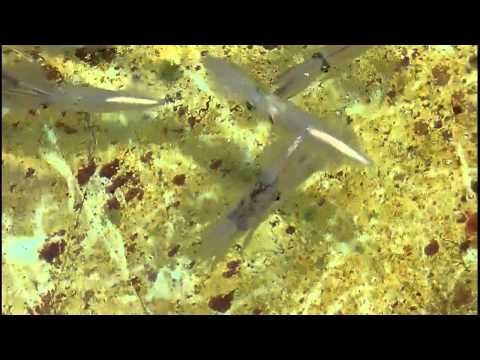More squid is caught in California waters than all other seafood species combined, making the market squid the state's largest and most valuable fishery. But has the fishery gotten too big?
Landings have been trending upward since the 1980s and for the last three years have met or come close to the catch limit. To put some numbers to this, nearly 268 million pounds of the tasty cephalopod were harvested in 2011, compared with 139 million pounds for all other seafood species combined.
With NOAA Fisheries-Sea Grant support, graduate student Charles Perretti and mathematical ecologist George Sugihara, both at Scripps Institution of Oceanography, UC San Diego, are tying to figure out how much squid is in the ocean and how much can be taken out without collapsing the stock.
By mid-2014, they hope to have an updated estimate of the squid's abundance off the coast, based on reproduction and survival as observed in the field. “My work is trying to bridge the worlds of mathematics and biology,” said Perretti, a recipient of a 2011 NOAA Fisheries-Sea Grant Population Dynamics Fellowship. “We want to make sure the stock stays healthy.”
When the squid return to their spawning grounds off La Jolla later this winter, he and colleagues will capture, tag, release and track female squid as they deposit their egg capsules on the seabed. They may also track some male squid.
The market squid, a cousin of the octopus, has a short lifespan of only 6 to 9 months, and like salmon, spawns and dies. Fishermen target squid during their mating orgies, at night using bright lights to attract the iridescent creatures to the surface.
Perretti’s challenge is to figure out how many eggs a typical female squid would deposit on the seafloor if there were no fishing. If this can be done, the number of eggs inside harvested females can be used to calculate an egg “escapement” rate from which an estimate of the next generation can be obtained. Actually doing this is the major goal of the project.
The squid tagging data will also be used to look at movements of squid from one spawning aggregation to another. This "mixing" has implications for the species' vulnerability to local depletions.
Scientists are also interested in being able to forecast ups and downs in squid populations several years in advance.
In collaboration with Stephan Munch at NOAA Southwest Fisheries Science Center in Santa Cruz, Sugihara and Perretti have been comparing the accuracies of different models for forecasting swings in fish population sizes. Results from this work – “Right Model, Wrong Prediction” – will soon be published in the prestigious Proceedings of the National Academy of Sciences.
“Ideally, we'd like to be able to provide the scientific framework for setting squid quotas, based on the stock's status and future projections, as is done for most other major fisheries in the U.S.,” Perretti explained.
More about the market squid fishery
The formal title of Perretti's fellowship project is “Development of Novel Stock Assessment Methods for Market Squid (Doryteuthis opalescens).”
Written by Christina Johnson
Videos

http://www.youtube.com/watch?v=0vES9XOphnE
About California Sea Grant
NOAA’s California Sea Grant College Program funds marine research, education and outreach throughout California. Headquartered at Scripps Institution of Oceanography at the University of California San Diego, California Sea Grant is one of 34 Sea Grant programs in the National Oceanic and Atmospheric Administration (NOAA), U.S. Department of Commerce.